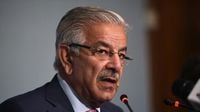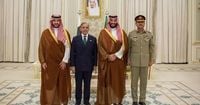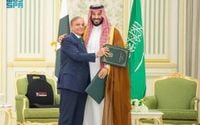In a move that has sent shockwaves through the Middle East and beyond, Pakistan and Saudi Arabia have formalized a defense pact that places the Kingdom under Islamabad’s nuclear umbrella, fundamentally redrawing the region’s security map. Signed on September 17, 2025, the agreement is not only a testament to the longstanding military ties between the two countries but also a clear signal to their regional rivals, particularly Iran and Israel, that the balance of power has shifted.
Pakistan’s Defense Minister Khawaja Mohammad Asif did not mince words when he confirmed the scope of the arrangement. In a televised interview with Geo TV on September 18, Asif stated, “What we have, and the capabilities we possess, will be made available to [Saudi Arabia] according to this agreement.” He emphasized that Pakistan’s nuclear capability, established decades ago with successful tests and a trained force, is now essentially extended to Saudi Arabia. “Let me make one point clear about Pakistan’s nuclear capability: that capability was established long ago when we conducted tests. Since then, we have forces trained for the battlefield,” Asif said. “This is an umbrella arrangement offered to one another by both sides: if there is aggression against either party — from any side — it will be jointly defended, and the aggression will be met with a response.”
The language of the pact, as reported by Reuters and the state-run Saudi Press Agency, leaves little ambiguity: “Any aggression against either country shall be considered an aggression against both.” The deal aims to “develop aspects of defense cooperation between the two countries and strengthen joint deterrence against any aggression.” This means that Saudi Arabia, for the first time, has access to nuclear deterrence without the complications and costs of developing its own weapons program—a shortcut that has long been rumored but never so openly acknowledged.
The timing of the agreement is telling. It comes in the immediate aftermath of an Israeli strike on September 10, 2025, in Qatar that killed six Hamas leaders, an event that heightened security anxieties across the Gulf. According to The Associated Press, the deal is widely seen as a direct response to such attacks, as well as to Iran’s long-standing posture of intimidation through its missile and drone arsenal. For years, Iran has acted with relative impunity, believing only Israel’s nuclear arsenal stood in its way. That calculus has changed overnight. As one analysis put it, “For Iran, this is a nightmare scenario. Instead of intimidating its neighbors with missiles and drones, Tehran now faces a two-front wall of deterrence: Israel to the west, Pakistan to the east, with Saudi Arabia in the middle backed by both.”
The strategic implications are profound. Saudi Arabia’s new status under Pakistan’s nuclear umbrella is seen by Gulf monarchies as the “ultimate insurance policy” against Iranian aggression. Turkey, which has often sought to position itself as the Sunni world’s heavyweight, is reportedly displeased at being sidelined. Meanwhile, Qatar, often aligned with Tehran, finds itself strategically isolated. The ripple effects extend beyond the region: Western intelligence agencies are said to be quietly relieved, viewing a stronger Riyadh as a counterbalance to Iran’s network of proxy forces.
Perhaps the most intriguing diplomatic consequence is the potential for Saudi Arabia to accelerate normalization with Israel under the Abraham Accords. With Pakistani protection, Riyadh may feel emboldened to pursue open relations with Israel, further cementing a pro-Western, pro-Israeli alignment in the region. As one commentary observed, “For Israel, this is nothing short of historic—proof that strength, not weakness, is the language that reshapes the Middle East.”
Yet, the risks are not lost on observers. The introduction of a nuclear umbrella in a region already riddled with flashpoints raises the specter of escalation. “Nuclear umbrellas are dangerous, and no one wants another flashpoint in a region already littered with them,” cautioned one Western analyst. Still, from a Western and Israeli perspective, the deal is seen as a strategic masterstroke that corners Tehran and undermines its decades-long campaign of proxy terror and nuclear blackmail.
The defense pact also has significant implications for global nuclear commerce. According to a detailed analysis published on September 19, 2025, the arrangement opens the door for China to build multiple Hualong One pressurized water reactors (PWRs) in Saudi Arabia. China has already constructed two such reactors in Karachi, Pakistan, as part of its Belt and Road Initiative. With U.S. and South Korean nuclear exports to Saudi Arabia hamstrung by legal restrictions and disputes over uranium enrichment rights, China is now poised to dominate Saudi Arabia’s civil nuclear program. This would allow Riyadh to trade oil for nuclear technology, freeing up millions of barrels of oil annually for export—a boon for both the Saudi and Chinese economies.
The roots of this arrangement stretch back decades. Saudi Arabia has long been suspected of providing financial support to Pakistan’s nuclear program, especially during periods of Western sanctions. Retired Pakistani Brigadier General Feroz Hassan Khan has publicly stated that Saudi funds were crucial to the survival of Pakistan’s atomic ambitions. In return, it has been widely believed—though never officially admitted until now—that Pakistan would extend its nuclear protection to the Kingdom if needed. “What did we think the Saudis were giving us all that money for? It wasn’t charity,” one senior Pakistani source told the BBC in 2013. Gary Samore, former U.S. counter-proliferation adviser, echoed this sentiment: “I do think that the Saudis believe that they have some understanding with Pakistan that, in extremis, they would have claim to acquire nuclear weapons from Pakistan.”
Pakistan’s nuclear arsenal, estimated at 170 warheads according to the Bulletin of Atomic Scientists, is roughly on par with India’s 172. Its Shaheen 3 ballistic missiles, with a range of 2,750 kilometers (1,700 miles), are capable of reaching Israel—a fact not lost on regional strategists. Both Pakistan and Saudi Arabia maintain monitoring agreements with the International Atomic Energy Agency, though the IAEA has yet to comment on the latest developments.
As the dust settles, the regional order appears fundamentally altered. Iran, once the region’s preeminent intimidator, now faces a coordinated wall of deterrence. Saudi Arabia, long content to wield its influence through oil and economic power, has taken a decisive step into the nuclear age—without the burden of building its own arsenal. And Pakistan, often isolated by Western sanctions, has leveraged its nuclear capability into unprecedented strategic influence.
The world will be watching closely as these new alliances take shape, and as the Middle East’s old certainties give way to a new, and potentially more dangerous, equilibrium.






